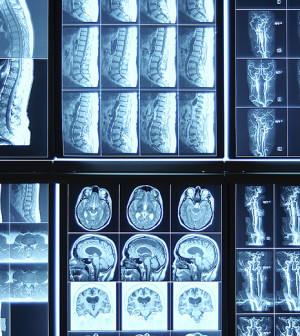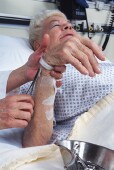- Skip Storing This Everyday Product in the Fridge Door
- Green Tea + B3 Pairing May Boost Brain Health
- Navigating Your Midlife Crisis: Embracing New Possibilities
- City Raccoons Showing Signs of Domestication
- Mapping the Exposome: Science Broadens Focus to Environmental Disease Triggers
- One Week Less on Social Media Linked to Better Mental Health
- Your Brain Changes in Stages as You Age, Study Finds
- Some Suicide Victims Show No Typical Warning Signs, Study Finds
- ByHeart Formula Faces Lawsuits After Babies Sickened With Botulism
- Switch to Vegan Diet Could Cut Your Greenhouse Gas Emissions in Half
Bed Position Matters for Stroke Patients, Report Shows


Hospital bed positioning can be critical in the first 24 hours after a person suffers an ischemic stroke, according to a new report.
Researchers summarized the latest research on ischemic stroke, the most common type of stroke, which occurs when a clot blocks blood flow to the brain. The other type is a bleeding (hemorrhagic) stroke.
“The period immediately following an acute ischemic stroke is a time of significant risk,” neurologists from Loyola University Medical Center in Maywood, Ill., said. “Meticulous attention to the care of the stroke patient during this time can prevent further neurologic injury and minimize common complications, optimizing the chance of functional recovery.”
Sitting upright can harm ischemic stroke patients because it decreases blood flow to the brain when it needs more blood, the researchers explained.
This would suggest that it’s best to keep these patients lying as flat as possible, but strokes can also cause brain swelling that can damage the brain. Keeping patients sitting upright helps improve blood drainage and reduces swelling, the authors noted.
“There are few data to guide decision making in this difficult situation,” wrote Dr. Murray Flaster and colleagues in a Loyola news release.
Another complicating factor is that some stroke patients have difficulty breathing while lying flat. In such cases, the head of the bed should be at the lowest elevation the patient can tolerate, according to the report published recently in the journal MedLink Neurology.
The report examined many other issues in stroke care, such as: blood sugar control; blood pressure management; use of cholesterol-lowering statin drugs; complications such as pneumonia and sepsis; heart attack and other heart problems; blood clots; infection; seizures; further strokes; brain swelling and bleeding; and malnutrition and aspiration.
Research has shown that patients treated at hospital units that specialize in stroke care are less likely to die, more likely to be able to return home, and have better functioning and quality of life, the report said.
More information
The American Heart Association has more about ischemic stroke.
Source: HealthDay
Copyright © 2025 HealthDay. All rights reserved.










